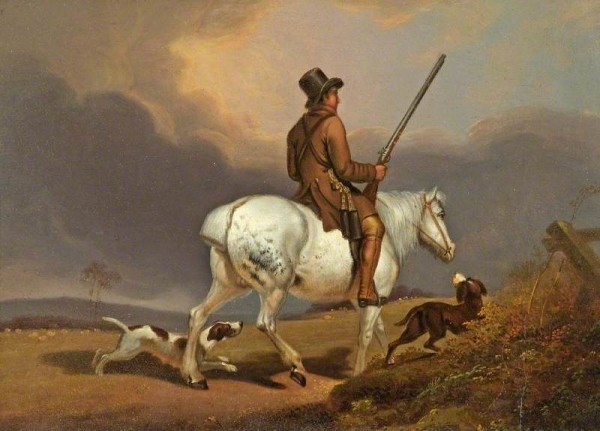
Cooper, Abraham; The Morning of the First of September; Cheltenham Art Gallery & Museum; http://www.artuk.org/artworks/the-morning-of-the-first-of-september-61725
Game shooting, which proved to be a pivotal point in my previous blog, is not something which forms any real part of my life – but my explorations into the painting ‘Making Pills for the Saxons’ led me to another painting in the Cheltenham collection. The title of this work is ‘The Morning of the First of September’ and is by a nineteenth century British artist Abraham Cooper. I have to admit that, again, it is not a painting which I particularly noticed in my early years at Cheltenham – rather dismissing it as yet another sentimental Victorian potboiler. In the light of my work on the ‘Making pills’ painting I decided to take another, more objective, look at this painting which also included a shot-gun. Depicted is a man on a horse holding a shot-gun, accompanied by two gun-dogs, standing alert in a rather wild countryside in the emergent light of a new day. So far so good – this was probably something to do with game shooting. But why a particular date, the first of September? On further exploration, which could have been much quicker if I was still living in rural Oxfordshire and asked friends in the village, I realised that this referred to one of the game shooting ‘seasons’ – in this case the start of the grouse shooting season. So here would have been a painting of a subject matter much admired and bought by the gentry and urbanites who went on regular shooting trips. The painting would have resonated with reminders of getting up in the early hours of a probably rather cold and wet early September – ready for the off. It is with some humility that I recognise that my attitude, along with many of my curatorial and art history colleagues, to ‘Victorian sentimental art’ stemmed from ignorance. Inevitably, it seems, one generation has to dismiss the previous generation – but there must come a point when that dismissal is itself questioned. Over the past few decades I have been interested in what might be called the ‘sociology of art collecting’ in the nineteenth century. In particular I have been exploring two particular strands – firstly a study of people living in Bristol and Gloucestershire, however ‘minor’, who were collecting paintings. The second strand is an in-depth study of the great and extensive collection of the 2nd Lord Northwick – in particular at the family seat at Northwick Park at Blockley and his mansion, Thirlestaine House, in Cheltenham. Whilst the collecting of ‘sentimental’ Victorian paintings by minor collectors could be understood as simply following prevailing fashion the collecting of such works by a major, judicious, and knowledgeable collector like Lord Northwick suggests that there is perhaps something missing in the aesthetic and historical judgement of a later generation, including our own. In a later blog I hope to discuss in greater depth the matter of why intelligent and cultivated nineteenth century collectors bought and commissioned such works as the one here under discussion. I would simply add at this point the important fact, often forgotten, that from the early decades of the nineteenth century in Britain there was a strong and serious movement to encourage contemporary British Art combined with a serious attempt to provide moral and educational guidance, through Art, for the population of a rapidly changing society which was in danger of being cut off from its social roots.
